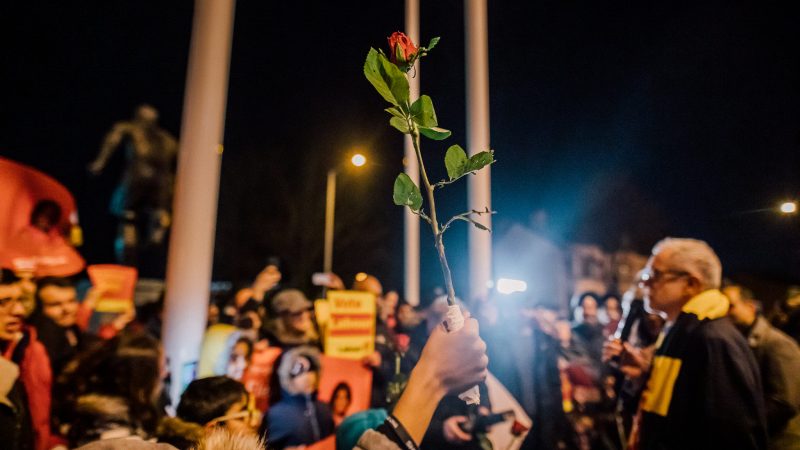
In April this year, after losing the leadership, deputy leadership and ruling body by-elections, the Labour left was pronounced dead. Just seven months later, it won a majority of the members’ seats on the party’s national executive committee (NEC). This is despite the introduction of single transferable vote (STV) – a voting system designed to produce a mixed outcome. There is much to learn from these results, and Charlie Mansell has produced a comprehensive overview of the key points of interest. I will focus on just one key question. How did the Labour left win?
How does STV work?
Before we can properly analyse the results, we must first understand the system that produced them. For voters, STV is quite simple. They rank as many candidates as they like from #1 at the top to the final candidate at the bottom, or for as many as they have the energy and interest. This is exactly the same as the ‘alternative vote’ (AV) system that members use to elect the party leader. The difference is how the results are counted. AV elects only one winner; STV elects many.
The votes are counted in rounds. The first round is straightforward: each candidate’s first preference votes are counted. After this, it gets a little more complicated. A quota is calculated from the total number of votes and number of seats to be elected. We were electing nine seats, so the quota was a tenth of the total votes: 12,954.9. At the end of each round, one of two things must happen. If a candidate has been elected with surplus votes (that is, more than the quota), this surplus must be redistributed; if not, the candidate with the fewest votes is eliminated and their votes redistributed.
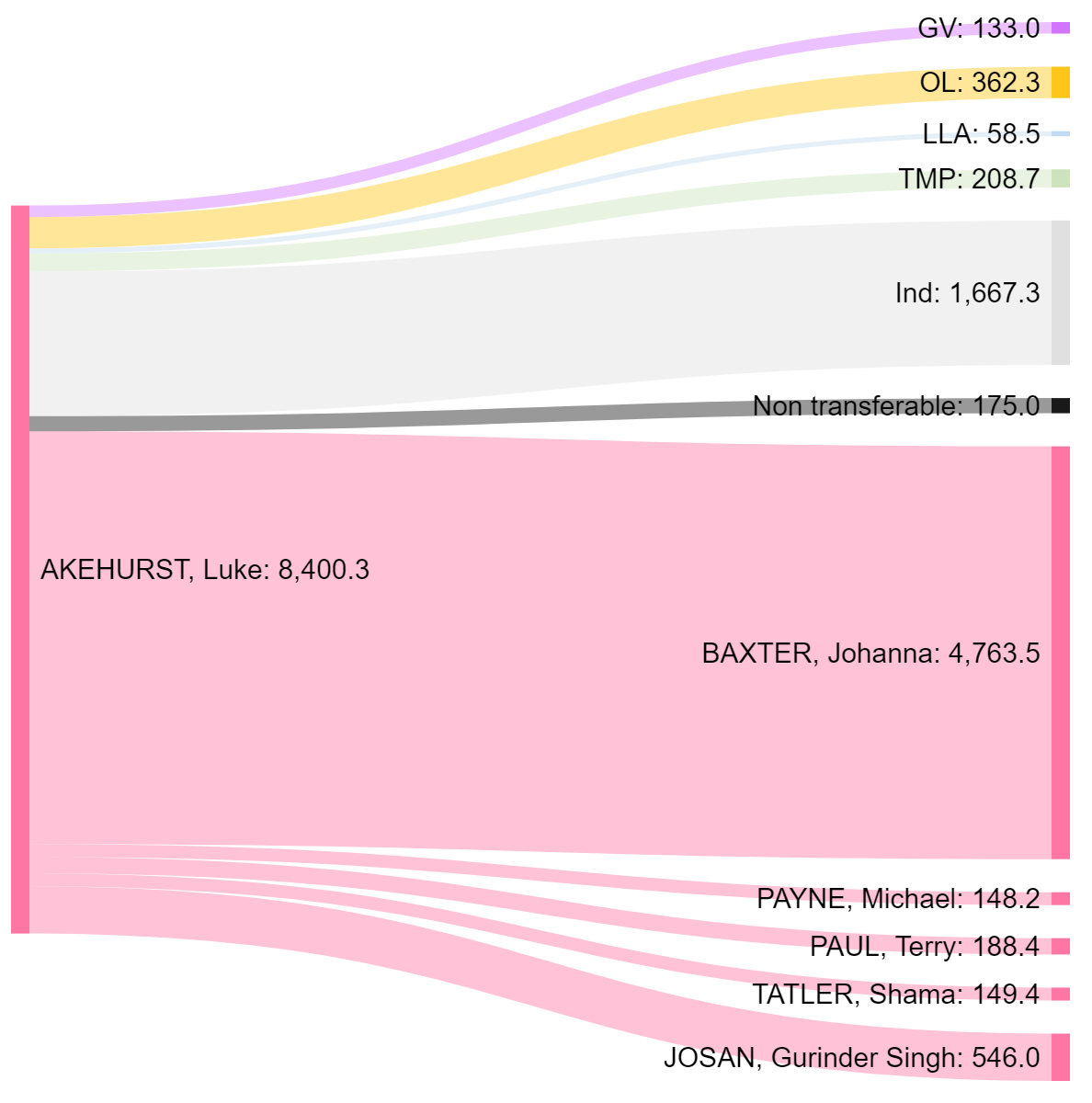 The redistribution of Labour to Win (LtW) candidate Luke Akehurst’s surplus votes. Transfers to Grassroots Voice (GV) are in purple, Open Labour (OL) is yellow, Labour Left Alliance (LLA) is pale blue, Tribune MPs (TMP) are pale green, independents are pale grey and Labour to Win are pink. The votes that could not be transferred at all appear in black.
The redistribution of Labour to Win (LtW) candidate Luke Akehurst’s surplus votes. Transfers to Grassroots Voice (GV) are in purple, Open Labour (OL) is yellow, Labour Left Alliance (LLA) is pale blue, Tribune MPs (TMP) are pale green, independents are pale grey and Labour to Win are pink. The votes that could not be transferred at all appear in black.
In our case, Akehurst and Laura Pidcock had enough votes to be elected in the first round. Akehurst had the most, so his surplus was redistributed first. He won 21,355 first preferences, which left a surplus of 8,400 over the quota. But his voters put a wide range of other candidates second. For instance, 12,110 put Joanna Baxter next. This is 57% of his total, so Baxter received 57% of his surplus (4,763) – this was enough for her to be elected too. Meanwhile, just 2% put Terry Paul next, so Paul won 2% of the surplus, 188 votes. 445 voters voted only for Akehurst and nobody else. This represented 2% of his total, therefore 2% of his surplus votes (175) were non-transferable and effectively wasted.
We do not know how many put Akehurst #1, Pidcock #2. She had already been elected when Akehurst’s surplus was redistributed, so she was not eligible to receive any of his transfers. It may be that some of his transfers to Baxter had Pidcock #2 and Baxter #3. For the purpose of the count, this makes no difference. Pidcock was already out of the count, so these votes were treated just the same as Akehurst #1, Baxter #2 votes.
If a round ends and no candidate has a surplus, the candidate with the fewest votes is eliminated and their votes redistributed too. This is done in much the same way as with the surplus votes from winning candidates; they transfer to the next candidate still in the race, ignoring all those already elected or eliminated. The only difference is that these transfer at their full value. Surplus votes transfer at a fraction of their value because part of the vote has already been used to elect someone. When a candidate is eliminated their votes have not been used at all, so they transfer at full value.
How do you win an STV election? There are four factors at play, and the left slate GV did well in all four. The first factor is the number of first preferences. The second is the proportion of a candidate’s votes that transfer to another candidate on the same slate – I call this slate loyalty. The third is the potential for a slate to win transfers from candidates on other slates – I call this slate attractiveness. The fourth and final factor is the number of rounds a candidate remains in the race, and is thus able to continue to collect transfers – I call this survivability.
First preference votes
First preference votes are the most important factor to determine the end result. They made up the majority of final votes for eight of the nine winning candidates and elected two candidates without any transfers at all.
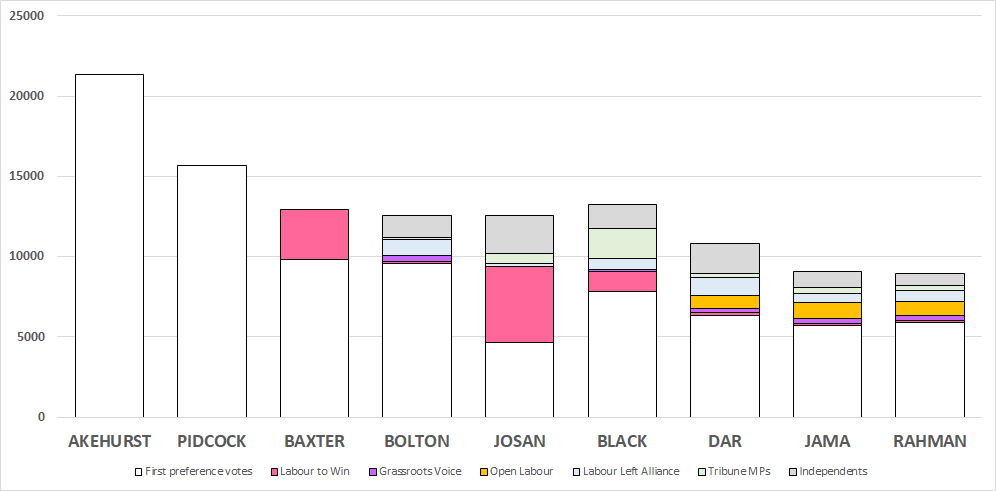
The composition of each winning candidates’ final vote. White indicates first preference votes, other colours indicate transfers from other candidates.
GV had enough first preferences to win three candidates and to be competitive for a fourth. After all the transfers, they won five. Meanwhile, LtW also had enough first preferences to elect three candidates. But that is all they won. In fact, by the time the count was finished and all the transfers had been redistributed they had fewer votes than in the first round. Thanks to the transfers, GV ended the count with 14,000 more votes than it started with. LtW ended with 2,000 fewer. This is explained by the remaining three factors: slate loyalty, slate attractiveness and survivability.
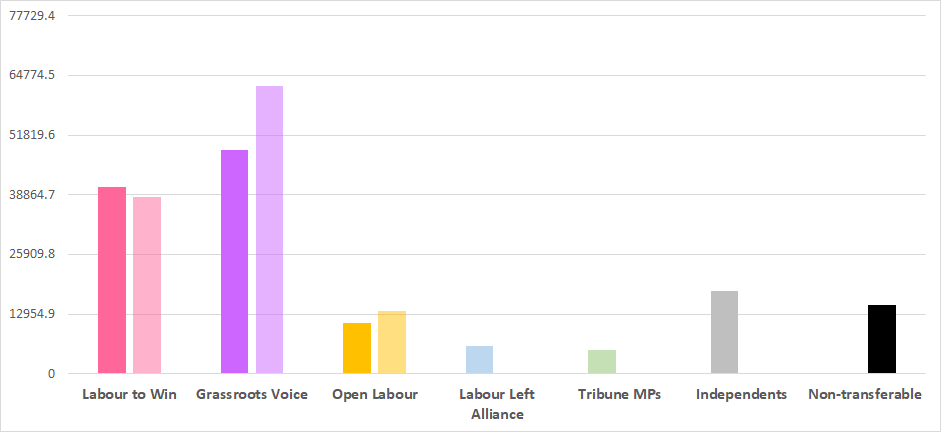
First preferences and final votes by slate. Opaque columns are first preference votes; transparent columns indicate the number of votes after all transfers.
Slate loyalty
Under a first-past-the-post election system, you need to win votes. With STV, you must win them and then keep them. When a candidate is either eliminated or elected with surplus votes, their votes must be transferred. If voters are loyal to the candidate’s slate, the votes will transfer to their teammates. If they are not, many will transfer to its opponents.
It can sometimes seem like the Labour Party is fiercely divided between opposing camps. In reality, many members are willing to pick and choose amongst different factions and ideological traditions. Every time a candidate was removed from the count – by election or elimination – that slate leaked votes to its opponents. In some cases, this was the vast majority of its vote. The TMP slate only held on to 29% of its vote when Liz McInnes was eliminated, and only 19% when Theresa Griffin was knocked out. Every candidate lost at least a quarter of its transferred vote to its rivals.
Pidcock and Akehurst enjoyed the highest slate loyalty of all candidates: 73% and 69% respectively. Other LtW candidates were slightly lower than Akehurst’s, dropping from 65% to 55%. In other words, they lost between a third and a half of their vote each time a candidate was excluded. GV, by contrast, only lost 27% from Pidcock. The other candidates were neither eliminated nor elected with a surplus so they kept all their votes. In all likelihood, the other candidates’ voters would have been more loyal than Pidcock’s. Pidcock’s popularity and name recognition will mean her reach exceeded the GV slate, so a higher proportion of her voters are likely to pick and choose between candidates.
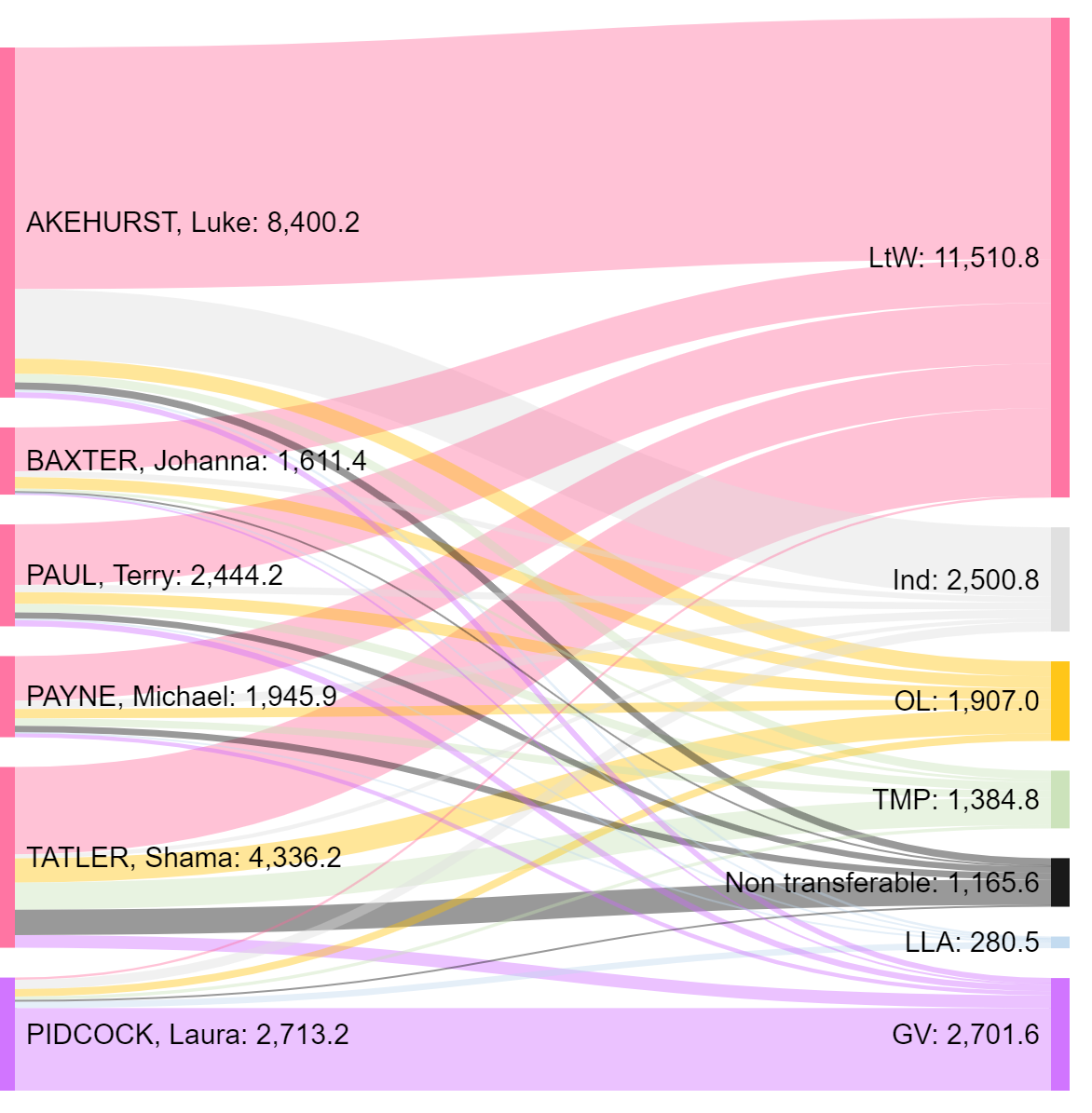
Transfers from Labour to Win and Grassroots Voice candidates.
Slate attractiveness
Slate attractiveness concerns the number of transfers a slate wins from its opponents. In a sense, it is the opposite of slate loyalty. The number of transfers between the two major slates is negligible. LtW won 2% of GV’s transfers, while GV won 3% of LtW’s.

Transfers by slate. Each chart shows the transfers from the labelled slate or group of slates. Each section of the chart indicates the destination of the transfers, e.g. the purple section on the LtW chart indicates the proportion of its transfers to GV.
But both LtW and GV won support from the minor slates and independents. At first glance, it looks like GV was vastly more popular than LtW with supporters of all minor slates. For example, GV won 41% of LLA’s transfers compared to just 4% for LtW.The most extreme was for OL – 40% of its transfers went to GV and none of them went to LtW.

Alarm bells should ring at that last sentence. It cannot be that literally zero voters put LtW as their next choice after OL. And it is probably not so. The numbers appear as such because OL’s votes only transferred after all of the LtW candidates were excluded from the count. In other words, there were no LtW candidates remaining to receive OL’s transfers.
Transfers by slate up to round 32. This is the same as above except it only considers transfers in the first 32 rounds of counting, before the final LtW candidate was excluded.
If we look at the transfers that took place before the final LtW candidate was excluded, the picture is more mixed. LLA’s transfers are unaffected but the others change considerably. TMP now sends more of its transfers to LtW than to GV, and transfers from independent candidates are split equally between the major slates. Overall, GV still won more transfers than LtW but not by such a huge margin, and primarily from the LLA.
Survivability
This brings us to the final factor: survivability. GV may have been more attractive to its opponents’ voters than LtW, but this was greatly exaggerated by its candidates surviving in the race for much longer. There were roughly 75,000 transfers over the course of the count. GV had candidates in the race for the whole duration, whereas LtW had no candidates in the race for the final rounds of the count. They were therefore ineligible for approximately 24,000 transferred votes.
First preference votes for GV and LtW candidates.
The difference between GV and LtW is the former’s strategy to equalise its candidates’ first preferences. GV issued six regional lists, putting its candidates in a different order for each one. As a result, all its candidates received at least 5,000 first preference votes, putting them all in the top nine. By contrast, LtW did little or nothing to guarantee their weaker candidates’ first preference votes and it really showed. Its strongest candidate won 16 times the first preference of its weakest. Its top two candidates each received more first preferences than the bottom four combined. Unsurprisingly, its candidates were eliminated much earlier. Its candidates were outlived by both of OL’s, one of the TMP’s and even one independent. Not one GV candidate was eliminated until the final round.
Conclusion
At the beginning of October, before the first votes were cast, I predicted the results from an analysis of Constituency Labour Parties (CLPs) nominations. I argued that GV would have the highest slate loyalty. This has proven to be true: 73% of Pidcock’s transfers went to fellow members of her slate, and this was the highest proportion of any candidate. I also argued that GV would attract the most transfers from independents and minor slates, albeit with a strong correlation between TMP and LtW. This, too, has proven true. I made no predictions about the distribution of votes amongst candidates on each slate because we did not know how each slate would try to shape this.
We now know. It is clear that GV’s vote equalisation strategy was a big success. It meant its candidates stayed in the race long enough to pick up many more transfers than LtW ever could. Moreover, with only one of its candidates ever having her votes redistributed, the potential for leakage was minimised. It may well be that this strategy won it the fifth seat. I suspect this will be the last time GV enjoys such an advantage, and that other slates will try to replicate it next time.
It is worth remembering, however, that although STV is complicated, it is not magic. A proportion of the results are determined by the complex flow of vote-transfers but much of the final outcome is already clear from the first preference votes. GV may have picked up a seat or two from its sophisticated electoral strategy, but the root of its success is the popularity of its political message. Most Labour members want two things: radical left-wing politics and a route to Downing Street. In a leadership contest, members expect both. Keir Starmer offered them this and won big. In an internal election, the former matters most. GV promised left-wing politics and Labour’s left-wing membership rewarded them for it.





More from LabourList
EXCLUSIVE: A Christmas message from Hollie Ridley
‘Carol of the Bells: Christmas, Ukraine’s resistance and the fight for freedom’
LabourList Christmas quiz 2025 round 3: 12 Days of LabourList Christmas